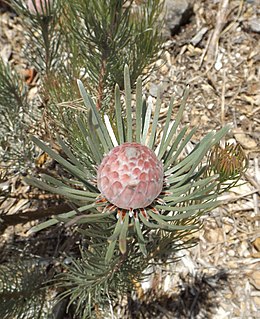
Mackerel is a common name applied to a number of different species of pelagic fish, mostly from the family Scombridae. They are found in both temperate and tropical seas, mostly living along the coast or offshore in the oceanic environment.

The Ogasawara subtropical moist forests is a terrestrial ecoregion which encompasses the Ogasawara Archipelago of Japan. The Ogasawara Archipelago lies in the Pacific Ocean south of Honshu, Japan's largest island, and north of the Marianas Islands. The ecoregion includes the Bonin Islands and Volcano Islands chains. The islands are volcanic in origin, and have never been linked to a continent. They are home to distinct plants and animals including many endemic species.

Sesamum is a genus of about 20 species in the flowering plant family Pedaliaceae. The plants are annual or perennial herbs with edible seeds. The best-known member of the genus is sesame, Sesamum indicum, the source of sesame seeds. The species are primarily African, with some species occurring in India, Sri Lanka, and China. The origin of S. indicum is uncertain, as it is widely cultivated and naturalized in tropical regions. The genus is closely related to the strictly African genus Ceratotheca and is itself probably African in origin.

A genet is a member of the genus Genetta, which consists of 14 to 17 species of small African carnivorans. The common genet is the only genet present in Europe and occurs in the Iberian Peninsula, Italy and France.

Notiosorex cockrumi, also called Cockrum's gray shrew or Cockrum's desert shrew, is a tiny species of shrews named in 2003. This red-toothed shrew, which is as light as a penny, is the first new mammal species from Arizona since 1977. Its range extends from Arizona to central Sonora, Mexico.

A species that is extinct in the wild (EW) is one that has been categorized by the International Union for Conservation of Nature as known only by living members kept in captivity or as a naturalized population outside its historic range due to massive habitat loss.
Aequatorium asterotrichum is a species of flowering plant in the family Asteraceae. It is endemic to Ecuador, where it grows in high Andean forest habitat.

Aequatorium jamesonii is a species of flowering plant in the family Asteraceae. It is found only in Ecuador. Its natural habitat is subtropical or tropical moist montane forests. It is threatened by habitat loss.
Aequatorium limonense is a species of flowering plant in the family Asteraceae. It is found only in Ecuador. Its natural habitat is subtropical or tropical moist montane forests. It is threatened by habitat loss.
Aequatorium repandiforme is a species of flowering plant in the family Asteraceae that is found only in Ecuador. Its natural habitat is subtropical or tropical moist montane forests, and the plant is threatened by habitat loss.
Aequatorium rimachianum is a species of flowering plant in the family Asteraceae. It is found only in Peru.

The Lake Pedder earthworm is an extinct earthworm species in the family Megascolecidae. Its genus Hypolimnus is monotypic.
Astronidium is a genus of plants in family Melastomataceae. It contains the following species :
Astronidium lepidotum is a species of plant in the family Melastomataceae. It is endemic to Fiji.

The Viverrinae represent the largest subfamily within the Viverridae comprising five genera, which are subdivided into 22 species native to Africa and Southeast Asia. This subfamily was denominated and first described by John Edward Gray in 1864.

Bourlon's genet is a genet species native to the Upper Guinean forests. It is known from only 29 zoological specimens in natural history museum and has been described as a new Genetta species in 2003. It is listed as Vulnerable on the IUCN Red List as the global population is estimated at less than 10,000 mature individuals.

Leucadendron album is a species of flowering plant in the family Proteaceae that grows in South Africa.
Tetramolopium lepidotum is a rare species of flowering plant in the aster family known by the common name Waianae Range tetramolopium. It is endemic to Hawaii, where today it is known only from the Waianae Mountains on the island of Oahu. It is threatened by habitat degradation caused by feral goats and pigs and introduced species of plants.

Phebalium lepidotum is a species of rounded shrub that is endemic to Western Australia. It has scaly branchlets, leathery, narrow oblong leaves and white to cream-coloured flowers arranged in umbels of between three and six on the ends of branchlets.












